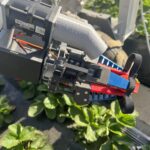Tricks to get compost in only two to three weeks

The content of this article 'Tricks to get compost in only two to three weeks' was prepared by www.agromatica.es and has been revised and republished by FreshFruitPortal.com.
We all know a stable, good quality compost that is able to nourish our crops takes a while, but if you don't have enough time try these tricks to get your soil faster.
Sometimes when we don’t have this stable, mature compost and we must resort to other solutions and in those situations check out this 14–20 day composting method.

Foundations of the rapid composting method
The composting process is mostly a compilation of biochemical processes (including aerobic fermentations) at variable temperatures depending on the process evolution.
In general, composting temperatures can reach a maximum of 65-70ºC, dying most organisms. This is when most of the microbial activity stops, and temperatures drop.
From this moment on, the pile cools down and moves on to the maturation process.
These processes generally take months. So how can we speed up this process?
Let's look at the foundations.
The rapid composting method was developed by the University of California, Berkeley with very satisfactory results.
This isn’t a complex method. No addition of activators or unusual elements in a compost pile is required, but more care and effort in certain aspects that we will mention later.
Obviously, without time, it is not possible to get a mature compost, mulch, or something similar, but we can have a young product that we can add on the surface so that it matures in the soil of the garden, along with the crops and at the same time providing nutrients from the first moment.
A mature compost is not better than a young one. It all depends on the use that you want to give to each one.

The method is based on 3 principles
Raw material balance or the carbon/nitrogen ratio
The ideal ratio is 30:1, although this is only a figure.
The composting process allows for variations in the ratio although this data is established as ideal.
We must keep on mind this ratio in the primary components of the composting process.
By maintaining this C/N ratio, we achieve the highest efficiency of organisms’ activity in the process.
This is perhaps the most difficult point to achieve if we don’t have the appropriate tools. Anyway, we leave some C/N ratios data of the most used materials.
Size homogeneity and crushing raw material
When we have time, we usually add plant debris, pruning and other elements to compost, in very heterogeneous shapes and sizes.
It isn’t necessary to do a previous work of crushing them when there is enough time for them to compost "at their own pace".
In the case of rapid composting, crushing and homogenization is essential for two reasons:
- By crushing, we multiply many times the contact surface of the material to be composted, achieving a considerable acceleration of the process.
- Homogeneity in the heap. In the slow and normal composting process, the materials are piled up progressively, in layers, so that the C/N ratios are not the same throughout the volume to be composted. By mixing well all the crushed elements we achieve total homogeneity, and the processes will be carried out in the whole pile equally and faster.
In addition to the above, there are direct consequences on the distribution of air and humidity in the compost pile.
Logically, air and humidity content and distribution are also homogenized, making the process faster and more efficient.
Turning frequency
The last of the 3 variables that make the composting process go from months to weeks is the turning frequency.
Most of the reactions in the process are aerobic fermentations. As the name implies, they need air to come to fruition and turning is the way to oxygenate the pile.
It is recommended to leave the compost pile for 2 to 3 days without moving until most of the processes have been activated and temperature has risen.
After that, turning must be done every 2 days. It implies an extra effort on our part, but let's remember that this is the method foundation to get compost in such a short time.

Final assessment
The time it takes for the compost to be available is highly variable.
Keep in mind that we are talking about 2 weeks if all the conditions of humidity, temperature, raw material balance, airing, etc., are kept within what the method considers ideal.
In most cases it’s difficult to perfectly control all the variables and the process will take a little longer.
We have already seen how to assess whether a compost is formed or not.
Use the methods of smell, color, and structure to make a quick assessment of the final product.
Advantages and disadvantages of this composting system
Outstanding advantages:
- First, and most obvious, the speed with which we get compost for our crops.
- Less nutrient leaching thanks to the speed of the process.
- Being a "thermally violent" fast process, the viability of weed seeds decreases.

Disadvantages of the system:
- It requires a more exhaustive control and more effort (turning).
- The amount of raw material must be abundant and available at once. A minimum of 1 m³ of compostable material is required.
- Achieving the C/N ratio is not easy. (It requires expertise and/or analytical methods).
- Possibility of crushing large quantities of the material to be composted (e.g. pruning waste shredder).
Source: www.agromatica.es














































